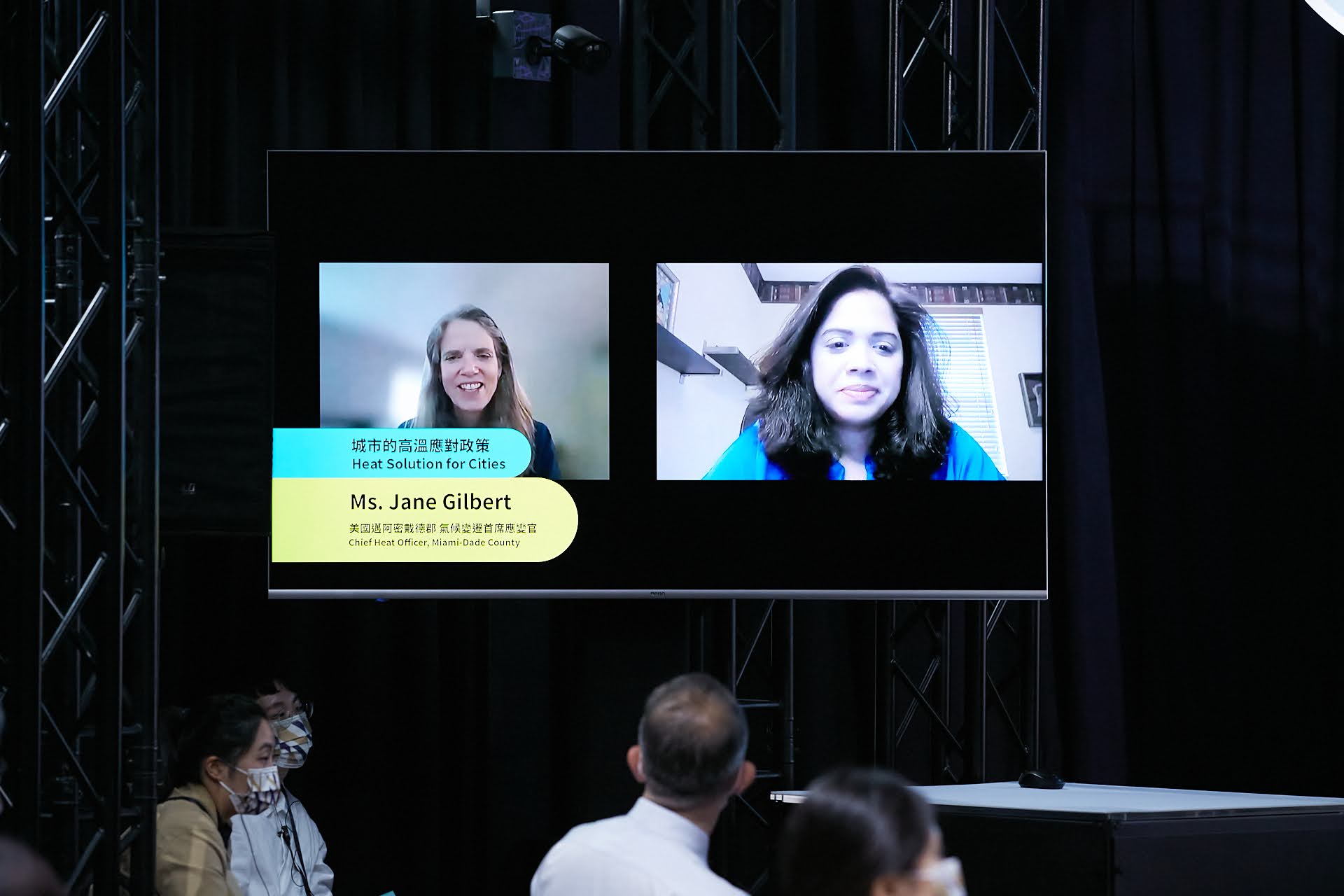【Event Highlights 04】Low Carbon Session: New Taipei, Utrecht, Miami-Dade, and MIH
2022-06-01
Contributer: Kevin Lai (Intern)
Co-editor: Patrick Ko (Intern)
The "2022 ING Earth Day Forum in New Taipei" held in New Taipei City on April 21st focused on sustainable topics, such as "low-carbon mobility" and "SDG City Leaders." More than 20 speakers from 4 states, 6 time-zones, 10 countries, and 15 cities as well as various international organizations, including the International Telecommunication Union (ITU), the United Cities and Local Governments Asia Pacific (UCLG ASPAC), Global Social Economy Forum (GSEF), Google, Mobility In Harmony (MIH), and Japanese think tanks attended the forum online and in-person. In this article, we would like to cover the remarkable exchanges in the "Low-Carbon Mobility" session.

Mr. Mitch Chung, Commissioner of the Transportation Department, New Taipei City
The Future of New Taipei City's Public Transportation
In the process of urban transformation, public transportation is the biggest source of pollution. Thus, the New Taipei City Transportation Department is trying to make a difference by creating a healthier environment which meets society's basic needs.
There are 4 million people living in New Taipei City, and it has been the core of the 10-million people living in the Taipei Metropolitan Area. To create the best living environment, New Taipei City puts its best effort into public transportation as it accounts for 34% of commutes nowadays with room for improvement.
There are 4 million people living in New Taipei City, and it has been the core of the 10-million people living in the Taipei Metropolitan Area. To create the best living environment, New Taipei City puts its best effort into public transportation as it accounts for 34% of commutes nowadays with room for improvement.
Comprehensive Electrification of New Taipei Urban Buses before 2030
According to Taiwan's national policy, it is expected to achieve the comprehensive electrification of urban buses by 2030. New Taipei City is looking forward to the increasing numbers of carriages and subsidy for the operation of public transportation.
In addition, the set up of new charging devices and an emphasis on smart bus dispatches were suggested, hoping that one day New Taipei City will become the core base of shared transportation such as buses, bicycles and electric scooter, etc.
In addition, the set up of new charging devices and an emphasis on smart bus dispatches were suggested, hoping that one day New Taipei City will become the core base of shared transportation such as buses, bicycles and electric scooter, etc.
YouBike 2.0 in New Taipei
There are 1,500 Youbike stations and more than 10 thousand YouBikes in New Taipei City with 100 thousand people using them every day. YouBike offers 24/7/365 service to cover the lack of bus schedules and routes.
Expansion of the charging system for shared scooters in New Taipei
The governance of usage and management of 17 thousand shared electric scooter is endorsed by the young-adult population between 25 to 34 years old. To expand the use of shared electric scooters, the New Taipei City Transportation department cooperates with corporations to build a large charging system, hoping to promote the convenience of shared scooters and free more space on the street.
New Taipei Green Community - To Build 190 Da'an Parks
Electric buses, public bikes, shared scooters and other shared carriages are gradually becoming part of every citizen's life. New Taipei City hopes to accomplish goals such as reaching the 500 millionth YouBike ride, turning 1,400 buses into electrical buses, and increasing the usage of public transportation from 34% to 40%. These goals are equivalent to planting 13 thousand trees or building 190 Da'an parks, as well as helping decrease air pollution and giving back to citizens a greener and cleaner environment.


Mr. David Chang, MIH Consultant (left), Mr. Mitch Chung, Commissioner of the Transportation Department (middle), Dr. Michael Lin, Research Scientist, MIT Media Lab City Science Group (right)
Mobility in Harmony
MIH stands for Mobility in Harmony. It hopes to build a peaceful commuting environment via cooperation. The difference between others and MIH is that it embraces an open electric commuting system, standardizing and sharing all software and hardware, like the Android system, to speed up innovation and development, thus reducing the cost of research.
MIH proposed the carbon neutrality playbook in April this year, promoting concepts which are increasing the number of people using electric cars and urging manufacturers and the public to support the goal of carbon neutrality. The energy conversion efficiency of gasoline is low, but by using an electric SUV produce, we can cut 40%of carbon emission, and even 60% if using 30% of renewable energy in the producing process.
To accomplish carbon neutrality, MIH expects to support the government in building the Carbon market, helping corporations to reach the goal of carbon neutrality through third-party certification and emission offset scheme. On the other hand, MIH hopes to use blockchain-tech to calculate carbon footprint and achieve carbon neutrality through incentives. MIH believes that artificial intelligence of electric cars will not only change the way of commuting but will also change the appearance of the city, originally built for cars.

MIH proposed the carbon neutrality playbook in April this year, promoting concepts which are increasing the number of people using electric cars and urging manufacturers and the public to support the goal of carbon neutrality. The energy conversion efficiency of gasoline is low, but by using an electric SUV produce, we can cut 40%of carbon emission, and even 60% if using 30% of renewable energy in the producing process.
To accomplish carbon neutrality, MIH expects to support the government in building the Carbon market, helping corporations to reach the goal of carbon neutrality through third-party certification and emission offset scheme. On the other hand, MIH hopes to use blockchain-tech to calculate carbon footprint and achieve carbon neutrality through incentives. MIH believes that artificial intelligence of electric cars will not only change the way of commuting but will also change the appearance of the city, originally built for cars.

Mr. Matthijs Kok, Senior Policy Advisor/Project Leader, City of Utrecht
Utrecht: Three Ways to Shrink Carbon Footprint of Travels
Travel less: a great urban planning can acchieve the goal of "travel less." The infrastructure in Utrecht has been planned near populated areas, reducing the amount of traveling of people. Furthermore, Utrecht encourages businesses to enable workers to work from home, to reduce the frequency of traveling. Last, by introducing parking tariffs, Utrecht hopes more citizens will use bicycles to reach their destinations.
Travel differently: 60% of residents in Utrecht commute by bicycle. Thus, setting up large biking garages is convenient for the public to transfer from one means of transportation to another. Additionally, Utrecht and other cities in the Netherlands introduced electric buses and different types of public transportation that use renewable energy, expanding the population's transportation options.
Travel efficiently: lastly, Utrecht sets up mobility hubs to encourage the public to rent electric cars and scooters or take electric buses. Utrecht already has 2,400 public charging stations and is setting up more, aiming to help change half of its cars into electric cars by 2030.

Travel differently: 60% of residents in Utrecht commute by bicycle. Thus, setting up large biking garages is convenient for the public to transfer from one means of transportation to another. Additionally, Utrecht and other cities in the Netherlands introduced electric buses and different types of public transportation that use renewable energy, expanding the population's transportation options.
Travel efficiently: lastly, Utrecht sets up mobility hubs to encourage the public to rent electric cars and scooters or take electric buses. Utrecht already has 2,400 public charging stations and is setting up more, aiming to help change half of its cars into electric cars by 2030.

Ms. Jane Gilbert, Chief Heat Officer, Miami-Dade County
Miami-Dade County: To Reduce the Heat Island Effect
Due to climate change, the sea level is rising, the heat island effect is worsening, and the pace of global warming is getting faster over time. Miami-Dade gets invloved in a collaborative planning on climate change and natural disasters, by improving its cross-departmental collaboration and working with partners in different counties, communities, and universities.
The heat caused not only higher number of illnesses and deaths than other natural disaters but also greater economic cost. Hence, through public education, especially through education for the most vulnerable, Miami-Dade avoids tragedies related to the heat. For example, Miami-Dade provides education to employers and employees to let them know how to access government subsidies and protection. Also, the government helps house owners improve buildings' energy efficiency by painting lighter colors on roofs and walls, which can reduce air-conditioning by 15%. Miami-Dade also enhances emergency management to avoid disasters caused by power outage.
To reduce the heat island effect, Miami-Dade sets the goal of getting to a 30% tree canopy. Trees not only cool the surrounding areas but also help absorb CO2. Meanwhile, it is beneficial for the residents' health, living equality, and wildlife conservation.
The heat caused not only higher number of illnesses and deaths than other natural disaters but also greater economic cost. Hence, through public education, especially through education for the most vulnerable, Miami-Dade avoids tragedies related to the heat. For example, Miami-Dade provides education to employers and employees to let them know how to access government subsidies and protection. Also, the government helps house owners improve buildings' energy efficiency by painting lighter colors on roofs and walls, which can reduce air-conditioning by 15%. Miami-Dade also enhances emergency management to avoid disasters caused by power outage.
To reduce the heat island effect, Miami-Dade sets the goal of getting to a 30% tree canopy. Trees not only cool the surrounding areas but also help absorb CO2. Meanwhile, it is beneficial for the residents' health, living equality, and wildlife conservation.
The ING Earth Day Forum not only invited business representatives to make remarks in the opening, but also invited city leaders from UCLG ASPAC, Japan, Australia, and the United States. To watch the full speeches, please visit our video section on this website!
Related Solutions
 Visitor:1011
Visitor:1011


